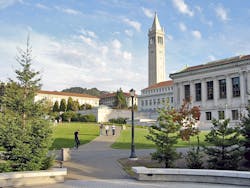Cal Berkeley testing Geothermal wells to replace fossil-fired CHP system on campus
The University of California, Berkeley has drilled a borehole, extending upto 400ft below ground to evaluate the feasibility of replacing its 40-year-old cogeneration system with a geothermal heat pump system for the heating and cooling requirements of the buildings.
The plan is part of its Clean Energy Campus Initiative. The engineers will first study the geological conditions below to determine the feasibility of establishing the system. Instruments donated by the Berkeley Lab, including a geothermal heat loop, will be used to evaluate the conditions.
Taka’aki Taira, a research seismologist at the Berkeley Seismology Lab, will install a geophone, which will measure seismic activity and data from the device will be used to monitor micro-earthquake activity near the campus.
“We need to replace this cogeneration plant because its useful life is almost over, and we want to pivot and build something for the future,” Kira Stoll, Chief Sustainability and Carbon Solutions Officer at UC Berkeley, said. “Our goal is to have the campus transition to using 100% clean energy to heat and cool our buildings by 2028. I’m looking forward to finding whether we do have geothermal potential on the campus and whether we can integrate that into our plans to make a very efficient clean energy system.”
The primary support for this borehole was provided by The Green Initiative Fund, funded by UC Berkeley student fees.
“Designing geothermal systems correctly is very important for reducing costs and ensuring their overall effectiveness,” said Peter Nico, Soil and Environmental Biogeochemist and Acting Division Director for the Energy Geosciences Division at Lawrence Berkeley National Laboratory (Berkeley Lab).
Rock and soil can absorb and store more heat energy without allowing it to diffuse. Geothermal heat pumps are designed to pump excess heat underground into boreholes for storage.
The data from this borehole will be used to build a ‘digital twin’ campus heating system so simulations can be run in order to develop the most efficient model for the new system.
The research could determine whether a centralized field of ground source heat pumps or boreholes at discrete locations on the campus will better serve the purpose.
Additionally, this research project will help train undergraduate and graduate students on designing and implementing these systems. They will also be able to learn how different technologies can be used together to decarbonize energy needs.
About the Author
EnergyTech Staff
Rod Walton is senior editor for EnergyTech.com. He has spent 17 years covering the energy industry as a newspaper and trade journalist.
Walton formerly was energy writer and business editor at the Tulsa World. Later, he spent six years covering the electricity power sector for Pennwell and Clarion Events. He joined Endeavor and EnergyTech in November 2021.
He can be reached at [email protected].
EnergyTech is focused on the mission critical and large-scale energy users and their sustainability and resiliency goals. These include the commercial and industrial sectors, as well as the military, universities, data centers and microgrids.
Many large-scale energy users such as Fortune 500 companies, and mission-critical users such as military bases, universities, healthcare facilities, public safety and data centers, shifting their energy priorities to reach net-zero carbon goals within the coming decades. These include plans for renewable energy power purchase agreements, but also on-site resiliency projects such as microgrids, combined heat and power, rooftop solar, energy storage, digitalization and building efficiency upgrades.
